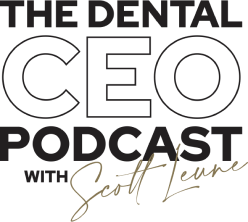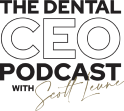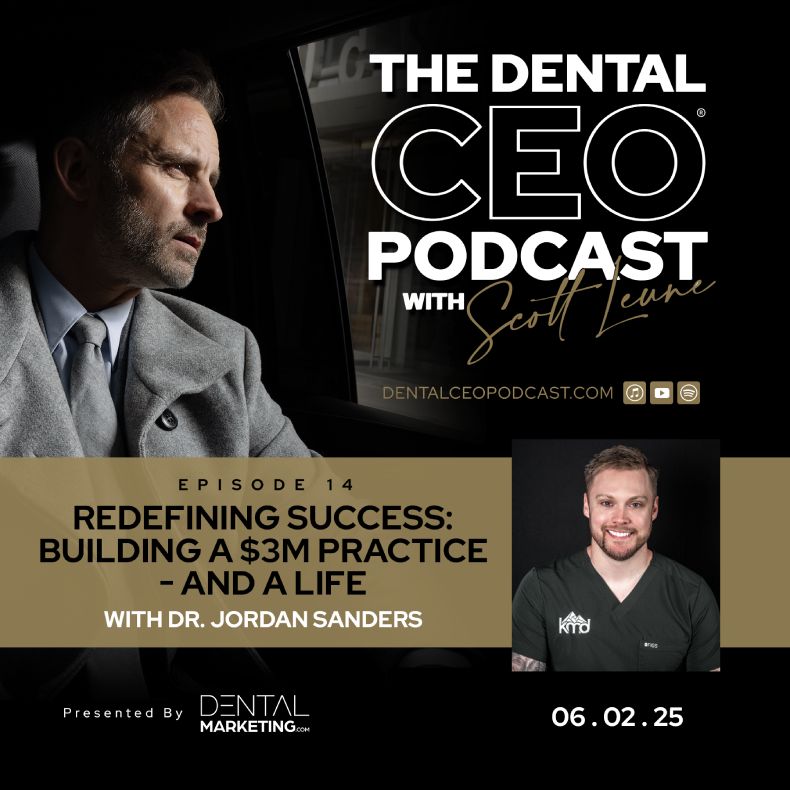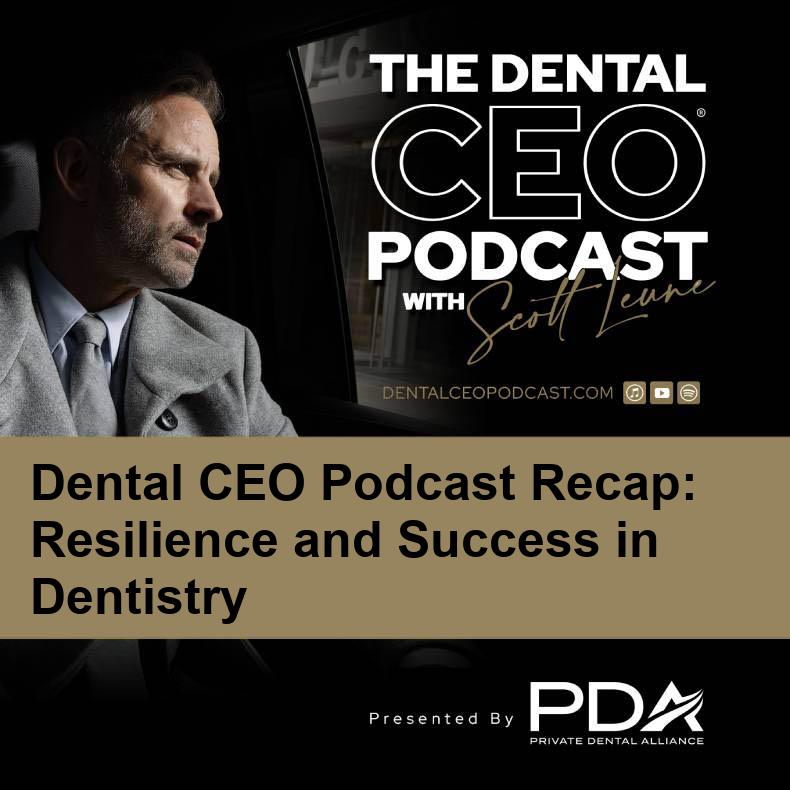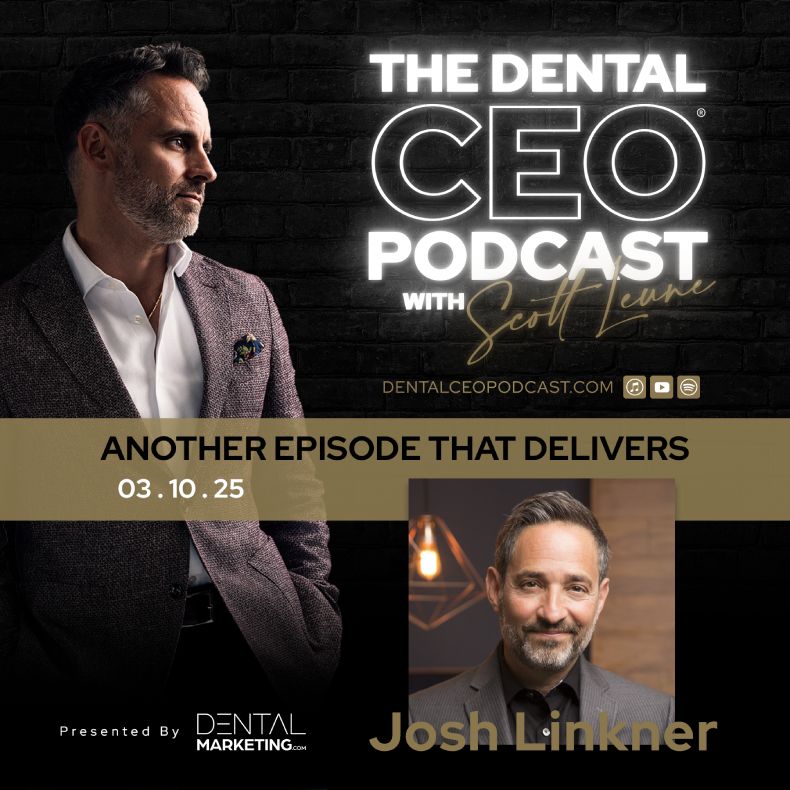Dental CEO Podcast #28 – Rethinking Dental Exams: A New Protocol to Increase Production
In this episode of the Dental CEO Podcast, host Scott Leune tackles the importance of a structured and organized exam process, introducing a revolutionary assessment strategy that maximizes patient care and profitability. Learn how implementing a systematic approach in the hygiene chair can lead to more accurate diagnoses, increased specialty procedures, and ultimately, a more successful dental practice. Whether you’re an associate or an owner, this episode is packed with insights to transform your practice and elevate your role as a dental entrepreneur.
Highlights
- Improving the Dental Exam Process – A critique of the traditional dental exam process and emphasizes the need for a structured and effective assessment protocol to maximize patient care and profitability.
- Implementing Assessment Protocols – Outline a a detailed assessment strategy for various dental procedures, including preventative, perio, ortho, implants, sleep, and cosmetic dentistry, to enhance diagnosis and treatment planning.
- The Role of Hygienists in Assessment Strategy – Discuss the importance of involving hygienists in the assessment process to ensure comprehensive treatment planning and consultation scheduling is discussed.
- Expanding Your Practice Through Assessment Strategy – How implementing a robust assessment strategy can potentially lead to practice growth
Speakers
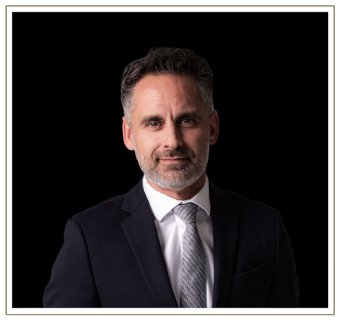
Dr. Scott Leune
Scott Leune, known as The Dental CEO, is one of the most respected voices in dental practice management. From his seminar room alone, he has helped launch over 2,000 dental startups and supported more than 20,000 dentists across practices worldwide. Named one of the 30 Most Influential People in Dentistry, Leune delivers practical, no-fluff strategies that empower dentists to lead with confidence, scale efficiently, and achieve real personal and financial success.
Watch Episode
Read Full Transcript
Scott Leune: So something that's bothered me my entire career is that the largest supply companies give huge discounts to the large DSOs, while private dentists have to just pay more and more and more for things every single year. What's also bothered me is that there are some buying groups out there in dentistry that claim to save private dentists a bunch of money, but those buying groups are still utilizing the big companies that have been overcharging dentists the entire time. And those buying groups aren't necessarily giving dentists the low pricing that the DSOs still get comes a solution, a new sponsor of ours, I'm super excited to announce that the Private Dental Alliance is trying to solve this problem. Finally, someone's doing it where private dentists only join their alliance and they get super low pricing on equipment supplies and lab fees, competing with the DSOs, putting them on a level playing field with the DSOs.
If you want to understand how much money you would save, text the word savings to 4 8, 6 5, 9 savings to 4 8, 6, 5, 9. Do that right now, and you will be able to see very quickly a price comparison of what you're currently spending with whoever you're spending it with to what life would look like if you were in the alliance. Be a private dentist that takes advantage of this. Save a ton of money. Don't keep going month after month, losing money because you just haven't gone through the process of joining the alliance. That's Private Dental Alliance. Super excited. Finally, we can save some real money as private dentists.
So I mean this with respect, but your exam process might be total shit. You might just be walking in a room and just looking in a mouth and just kind of seeing what you see, calling off what you're going to call off and walking out and thinking that that is the best way to have an exam. And I think that that is a very poor way of having an exam. So what I want us to focus on right now is can we get really organized and really effective with how the hygienist and how the doctor looks at a patient does the exam so that we have diagnosed everything someone needs. We've maximized the amount of specialty procedures we're going to do, whether this is an associate driven practice or an owner driven practice, the end result is going to be the highest level of care with the highest profit margin. And that is what we're going to talk about today in the dental CEO podcast. Can we put in an assessment protocol and the hygiene chair to maximize the dentistry that we diagnose and that we do?
Let me use an analogy for a second. Let's say you are a chef and you want to run a restaurant cooking food. A very poor way of cooking food is to kind of take a pinch of that and a pinch of this and kind of throw some things together and kind of stirred up and make the food and serve it. Because every time you serve that food, you might leave something out. You might take too long, you might not take long enough, it's going to taste differently. That would not be a standardized way of making food in the restaurant. What we need instead is we need a recipe. We need it followed. We need the timing down. We need it so that the end result has the best food in an appropriate amount of time. I want to do that in the hygiene chair. So what I want to do is I want to look at that time the patient's in the hygiene chair that hour or that hour and a half where we are doing a pre-diagnosis with a hygienist.
We're doing an official diagnosis with the dentist. Of course we're treating the patient. Can we take that time and put a recipe to it, a formula to it so that every single patient gets every piece of our thorough exam that we need to have? And when we follow that recipe, it triggers dentistry to be diagnosed or consultations to be scheduled. This is incredibly important in an associate driven model where we're trying to refer dentistry to a specialist or to an owner. But it is also incredibly important if you're the only dentist in a practice, we got to make sure that our human nature and our busyness and our tiredness doesn't cause us to get into the habit of skipping over, looking for specific types of dentistry to fulfill clinical needs the patient has. So the concept here is to have a series of assessments, an assessment.
What is an assessment? It's looking for certain things or asking certain questions. And if we find something or if the answer to the question was a yes, that should trigger either a diagnosis or a consultation. So for example, very, very simple. Is the patient missing teeth? If the answer is yes, we likely need to have some sort of consultation about implants. So that concept, if we see this, then we do. That needs to be a mandatory, disciplined, organized thing that we put in place in the hygiene chair. So I want to go through examples of this and I hope that this makes you kind of reset how you have that choreographed exam experience for the hygiene patient. So the first assessment we probably need to look at is the preventative assessment. What is preventative dentistry? It's probably sealants and fluoride. You could also say night guards, whatever your list is.
What do you need to see in the chair to then automatically say, yes, we need to diagnose sealants and fluoride. You might say, if we have a child or if it's an adult that has a cavity, all of those patients automatically need to have sealants and fluoride. So in your exam assessment, you would go through and step one would be, is this a child? Yes or no? Is this an adult with a cavity? Yes or no? And if you get a yes, we now need fluoride varnished twice a year and we need non restored molars sealed. Next step perio. Well, what perio? What are we going to see? We might call it in our assessment a five millimeter pocket or more. And if we have a five millimeter pocket, then we must diagnose our whole perio protocol. It could be scaling, it could be use of a laser for bacterial decontamination.
It could be use of antibiotic therapy. It could be something that medication we put in, a mouthpiece they wear at night. Whatever that protocol is, the series of procedures should automatically be inputted if our patient has five millimeter or more pockets. So we do preventative is a child, is an adult with cavity, we do perio. Do we have 5 million pockets or more? Then we go into some of the other specialties. What about ortho? Do they have crowding or do they have spacing? If so, we need to trigger a conversation about ortho. And it is great of course if we're doing a scan first so that we can have this conversation right there with the patient. So part of our assessment is doing the scan, the digital scan. We do the digital scan. The patient looks at their teeth, we talk about there's crowding here or there's spacing here, and that should trigger a consultation with whoever does ortho.
Now let's pause for a second. What does that actually mean in a group practice, right? In a group practice, one huge struggle, one huge weakness we have is that our associate dentist or a partner dentist aren't looking for the kind of dentistry they don't do. And so what happens is you might be the owner of a practice saying, Hey, I want to do all the bracketed, ortho, and all the clear aligners, right? I'm going to give all my associates the rest of the dentistry, but I want to focus just on that. And then what you find is your associates aren't sending you hardly any patients because they're not talking about it. They're just looking for fillings and crowns and surgeries and so forth. So that's a massive financial miss and it's very frustrating and it's not good for the patient. So what we need to do is in the hygiene chair, if the hygienist, after doing the scan sees that there's crowding or spacing and the patient is interested, the hygienist is mandated to treatment plan and ortho consultation with the owner.
You see, we're going to rely on the hygienist through an assessment process to automatically treatment plan that consultation with the owner. That can be for ortho, implant, sleep, cosmetic, facial aesthetics, wisdom teeth, I mean, name it. We can mandate the consultation with the owner. We take it out of the hands of the associate dentist who's not really looking for it, and we put it into the hands of the hygienist to treatment plan, the consult based on this assessment strategy. So if we have, after the scan, if we have crowding, we have spacing, we automatically, we automatically schedule consultation, ortho consultation with the owner. Now these consultations, by the way, if you're really good at the assessment strategy, you get loaded up with consultations and you may look at that as good or bad. You could say, oh, I love it. I got all this chair time.
I want to be an owner that just does specialty procedures. Yes, please fill my chairs with consultations, and that's great. And then you'll do the consultations. Or you might look at it like, I don't have time for all these consultations and some of 'em don't show, and I don't know if I want my whole schedule filled with consultations. That's the owner that needs to do a virtual screening first, a virtual consultation potentially. But all these people that have been treatment planned as needing consultations, you as the owner can go in every day, look at their photos, look at their scan, look at their x-rays, and immediately decide, do you want to move forward with the next step of scheduling them or not? That's a wonderful thing to do, whether you're the owner doing the specialty procedures or even if you are a traveling specialist, those of you listening to this that don't own a practice, but you travel, and let's say you take out wisdom teeth or you place implants, getting a virtual screening of the patient list first before you then commit to scheduling for consultation in your schedule is maybe a very smart thing to do.
But we need to have a huge load of consultation, like a huge flow, a massive amount of consultations, because that of course is going to maximize the dentistry we do and how we help people. And to get the biggest flow of consultations, we need to do it through this assessment strategy in the hygiene chair. So let's go back. I said, okay, we're going to have a preventative assessment. We're going to have a perio assessment, we're going to have an ortho assessment, and I mentioned implant assessment, right? If someone's missing teeth, let's trigger that to be an implant consultation with whoever places implants. Then we might go into a sleep assessment. If you're a dentist that does sleep dentistry, can we come up with a couple questions on a questionnaire and can we come up with maybe a measurement or two that is going to be done in the hygiene chair, maybe by the hygienist?
And if we get a yes, it triggers a sleep consultation with the dentist that does sleep dentistry, maybe a lifesaving sleep consultation by the dentist that does sleep dentistry, right? Let's put that in the hygienist hands. We can continue that with, of course, wisdom teeth. Is this patient age 15 to 30 with wisdom teeth? Let's go ahead and treatment plan the consultation or treatment plan, the screening. And that's how you could do it. By the way, lemme back up. If you are a practice that is going to screen the patients first before you schedule them, what you would do is you wouldn't treatment plan the consultation, you'd treatment plan the screening, right? So you'd create a custom code that would be wisdom teeth screening, right? And your hygienist would treatment plan that, and then you as the wisdom teeth dentist would every day or once a week, you would go and dive in and pull a report of all those people that were treatment plan for screening and make decisions on them and pull out the ones that need consults and contact those patients to bring 'em in.
So preventative assessment, perio, ortho implants, sleep wisdom teeth. What about cosmetic dentistry? Can the hygienist take a smile photo? Can the hygienist use chat GPT to take that smile photo and immediately show a simulation of what a perfect smile looks like on that patient? Can the hygienist take a shade? So those few minutes, take a photo, Chachi petite, take a shade. If that raises the interest level of the patient for cosmetic dentistry, let's go ahead and then be triggered to schedule a consultation for that consultation where you'll do a proper set of images, a proper scan, multiple may smile simulations, and you will talk to the patient and maybe their spouse about what a true cosmetic case looks like for them. What if every single patient in the hygiene chair got that? You'd probably be doing more big cases, and we don't have to stop at cosmetic dentist.
We can go also into facial aesthetics. Facial aesthetics. Some of you do that, A lot of you should look into it. But can we come up with a questionnaire? The patient answers a few questions and we look specifically at their face at specific items. We're looking for specific things that would trigger us to say, Hey, you're a candidate for microdermabrasion or for M face or for filler or PRF or Botox. And that can trigger a consultation with the dentist or with the person that does those facial aesthetics procedures. Let's say you're drinking my Kool-Aid right now, and let's say you have a group practice with three associates or multiple locations maybe, and you are able to put this in place in the hygiene chair. Wouldn't you agree that with ortho assessments you do more ortho with implant assessments, with automatic implant consultations being scheduled, you do more implants with sleep assessments, you would help more patients with sleep apnea with these assessments.
It would trigger you to do more screenings virtually and more consultations and more cases, and you might be right now complaining you don't do enough of these cases. And here's the other thing, if you're successful with the implant assessment, it might trigger you to say, you know what? Let me go learn sleep dentistry now because now we know how to get consultations from our patient base, even if it's with an associate dentist. Now that we got that foundation, we built that muscle in our practice, let's go learn more of these procedures so that we can do more of 'em. We have to have the referral muscle built and working. So once we have that referral muscle built, let's go do other procedures we can get referred referrals from. So these assessments, and again, I don't want to make it seem like it's only specialty procedures.
You can do assessments for preventative procedures. Like I said, you could do it for perio. You may also be able to do it for other general dentistry that you do and night guards and so forth. All of these assessments, what it really is is a very structured, organized way to do an exam. Very structured and organized. But what we've done is we've kind of put this mandatory treatment planning of a screening or consultation to that. And so now when we do an exam, we're almost going through what a doctor might do, like a review of systems. We're going through a review of these categories. I'm looking at disease and decay, and of course I'm also looking at preventative. I'm looking at perio. Now I'm looking at ortho, now I'm looking at implants. I'm looking at sleep cosmetic wisdom, teeth, facial aesthetics. And if I'm triggered by either what I see or by a question that was answered, if I'm triggered, I will automatically schedule a treatment plan, either the virtual screening or the true consultation with the dentist that does that work.
This concept might just be a little entertainment moment for your morning or your evening as you're listening to this podcast, and it doesn't change your life at all, but someone listening to this is going to become passionate about implementing this. They are literally going to create an assessment exam form. They're going to create the screening codes. They are going to become passionate about implementing this. And when you fast forward a year or two later, they are going to be doing a ton of these cases and they are going to then be, it's a domino effect. They might say, oh my God, I do a lot of these cases with my one location. I think I should open another one. I think I need to have three or four locations because if I've got this muscle of getting referrals and I've got four different locations, I can do a whole lot of these cases.
I could start building this kind of hub and spoke model where all my locations refer this kind of dentistry to my specialty team, and suddenly you have become an entrepreneur playing a much bigger game. You are a CEO with much more revenue coming in. You can afford to pay your team a lot more money. You can afford the technology you want. You can afford to open that other location or own the building. This is a domino effect that can be huge if you become a practice that can do a ton of these cases. And to do a ton of those cases, we got to find them first and we got to refer 'em to ourselves properly. And that is through this strategy of an assessment during the hygiene chair exam. I hope this was interesting to you. I hope someone is going to take this and be passionate about it.
Tune in of course, to all of these episodes. We really appreciate your support. Could you please either subscribe or post a review? We're trying to make this thing really valuable and big. And the more people that subscribe, the more people that post reviews, it helps us. So if you get value from this, can you reciprocate the value and help us as well with that small ask? I hope so. I hope that this is worth it for you, and I hope that you enjoyed this episode on assessments of the Dental CEO podcast. See you next time.
SUBSCRIBE TODAY
Subscribe now and receive a 25% discount code for Scott Leune’s upcoming events. Plus, get podcast episode alerts and exclusive subscriber perks.
